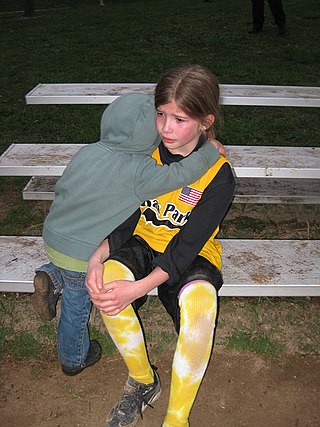
Altruism is the principle and practice of concern for the well-being and/or happiness of other humans or animals above oneself. While objects of altruistic concern vary, it is an important moral value in many cultures and religions. It may be considered a synonym of selflessness, the opposite of selfishness.
Psychological egoism is the view that humans are always motivated by self-interest and selfishness, even in what seem to be acts of altruism. It claims that, when people choose to help others, they do so ultimately because of the personal benefits that they themselves expect to obtain, directly or indirectly, from so doing.

In evolutionary biology, reciprocal altruism is a behaviour whereby an organism acts in a manner that temporarily reduces its fitness while increasing another organism's fitness, with the expectation that the other organism will act in a similar manner at a later time.

Empathy is generally described as the ability to take on another's perspective, to understand, feel and possibly share and respond to their experience. There are more definitions of empathy that include but is not limited to social, cognitive, and emotional processes primarily concerned with understanding others. Often times, empathy is considered to be a broad term, and broken down into more specific concepts and types that include cognitive empathy, emotional empathy, somatic empathy, and spiritual empathy.
Sympathy is the perception of, understanding of, and reaction to the distress or need of another life form.
Reciprocity is a crucial aspect of how people interact and live in society but researchers who study these interactions have often overlooked its importance. Reciprocity, as a fundamental principle in social psychology, revolves around the concept that individuals tend to respond to the actions of others in a manner that mirrors the positive or negative nature of those actions. It involves a mutual exchange of behaviors and reactions, where individuals reciprocate the same type of behavior they have received from others. People's choices in how they behave are mostly based on what they can gain from others in return, while feelings of trust, liking, and togetherness are strongly influenced by the idea of giving and receiving equally
C. Daniel Batson is an American social psychologist. He has two doctoral degrees, in theology and psychology. Batson obtained his doctorate under John Darley and taught at the University of Kansas. He retired in 2006 and now is an emeritus professor in the psychology department of the University of Tennessee. He is best known for his contributions to the social psychology of altruism, empathic concern, and psychology of religion.
Empathy-altruism is a form of altruism based on moral emotions or feelings for others.
The concept of the evolution of morality refers to the emergence of human moral behavior over the course of human evolution. Morality can be defined as a system of ideas about right and wrong conduct. In everyday life, morality is typically associated with human behavior rather than animal behavior. The emerging fields of evolutionary biology, and in particular evolutionary psychology, have argued that, despite the complexity of human social behaviors, the precursors of human morality can be traced to the behaviors of many other social animals. Sociobiological explanations of human behavior remain controversial. Social scientists have traditionally viewed morality as a construct, and thus as culturally relative, although others such as Sam Harris argue that there is an objective science of morality.
Prosocial behavior, or intent to benefit others, is a social behavior that "benefit[s] other people or society as a whole", "such as helping, sharing, donating, co-operating, and volunteering". Obeying the rules and conforming to socially accepted behaviors are also regarded as prosocial behaviors. These actions may be motivated by empathy and by concern about the welfare and rights of others, as well as for egoistic or practical concerns, such as one's social status or reputation, hope for direct or indirect reciprocity, or adherence to one's perceived system of fairness. It may also be motivated by altruism, though the existence of pure altruism is somewhat disputed, and some have argued that this falls into philosophical rather than psychological realm of debate. Evidence suggests that pro sociality is central to the well-being of social groups across a range of scales, including schools. Prosocial behavior in the classroom can have a significant impact on a student's motivation for learning and contributions to the classroom and larger community. In the workplace, prosocial behaviour can have a significant impact on team psychological safety, as well as positive indirect effects on employee's helping behaviors and task performance. Empathy is a strong motive in eliciting prosocial behavior, and has deep evolutionary roots.
Empathic concern refers to other-oriented emotions elicited by, and congruent with the perceived welfare of, someone in need. These other-oriented emotions include feelings of tenderness, sympathy, compassion and soft-heartedness.
The negative-state relief model states that human beings have an innate drive to reduce negative moods. They can be reduced by engaging in any mood-elevating behaviour, including helping behaviour, as it is paired with positive value such as smiles and thank you. Thus negative mood increases helpfulness because helping others can reduce one's own bad feelings.
In psychology, personal distress is an aversive, self-focused emotional reaction to the apprehension or comprehension of another's emotional state or condition. This negative affective state often occurs as a result of emotional contagion when there is confusion between self and other. Unlike empathy, personal distress does not have to be congruent with the other's state, and often leads to a self-oriented, egoistic reaction to reduce it, by withdrawing from the stressor, for example, thereby decreasing the likelihood of prosocial behavior. There is evidence that sympathy and personal distress are subjectively different, have different somatic and physiological correlates, and relate in different ways to prosocial behavior.
Warm-glow giving is an economic theory describing the emotional reward of giving to others. According to the original warm-glow model developed by James Andreoni, people experience a sense of joy and satisfaction for "doing their part" to help others. This satisfaction - or "warm glow" - represents the selfish pleasure derived from "doing good", regardless of the actual impact of one's generosity. Within the warm-glow framework, people may be "impurely altruistic", meaning they simultaneously maintain both altruistic and egoistic (selfish) motivations for giving. This may be partially due to the fact that "warm glow" sometimes gives people credit for the contributions they make, such as a plaque with their name or a system where they can make donations publicly so other people know the "good" they are doing for the community.
Social preferences describe the human tendency to not only care about one's own material payoff, but also the reference group's payoff or/and the intention that leads to the payoff. Social preferences are studied extensively in behavioral and experimental economics and social psychology. Types of social preferences include altruism, fairness, reciprocity, and inequity aversion. The field of economics originally assumed that humans were rational economic actors, and as it became apparent that this was not the case, the field began to change. The research of social preferences in economics started with lab experiments in 1980, where experimental economists found subjects' behavior deviated systematically from self-interest behavior in economic games such as ultimatum game and dictator game. These experimental findings then inspired various new economic models to characterize agent's altruism, fairness and reciprocity concern between 1990 and 2010. More recently, there are growing amounts of field experiments that study the shaping of social preference and its applications throughout society.
Evolutionary biologists have developed various theoretical models to explain the evolution of food-sharing behavior—"[d]efined as the unresisted transfer of food" from one food-motivated individual to another—among humans and other animals.
Reciprocal altruism in humans refers to an individual behavior that gives benefit conditionally upon receiving a returned benefit, which draws on the economic concept – ″gains in trade″. Human reciprocal altruism would include the following behaviors : helping patients, the wounded, and the others when they are in crisis; sharing food, implement, knowledge.
Moral emotions are a variety of social emotions that are involved in forming and communicating moral judgments and decisions, and in motivating behavioral responses to one's own and others' moral behavior. As defined by Jonathan Haidt, moral emotions "are linked to the interests or welfare either of a society as a whole or at least of persons other than the judge or agent". A person may not always have clear words to articulate, yet simultaneously, that same person knows it to be true deep down inside.
An empathy gap, sometimes referred to as an empathy bias, is a breakdown or reduction in empathy where it might otherwise be expected to occur. Empathy gaps may occur due to a failure in the process of empathizing or as a consequence of stable personality characteristics, and may reflect either a lack of ability or motivation to empathize.
Parochial altruism is a concept in social psychology, evolutionary biology, and anthropology that describes altruism towards an in-group, often accompanied by hostility towards an out-group. It is a combination of altruism, defined as behavior done for the benefit of others without direct effect to the self, and parochialism, which refers to having a limited viewpoint. Together, these concepts create parochial altruism, or altruism which is limited in scope to one's in-group. Parochial altruism is closely related to the concepts of in-group favoritism and out-group discrimination. Research has suggested that parochial altruism may have evolved in humans to promote high levels of in-group cooperation, which is advantageous for group survival. Parochial altruism is often evoked to explain social behaviors within and between groups, such as why people are cooperative within their social groups and why they may be aggressive towards other social groups.







